Space Quest: Flying to the Universe(2)
Space shuttle
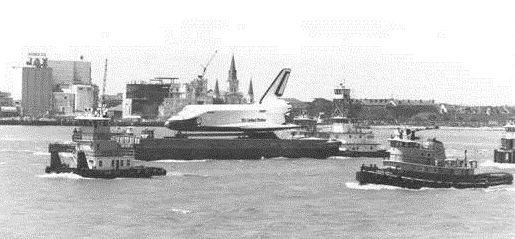
Space Shuttle Enterprise at World ExpoNew Orleans 1984
Space shuttle is a thrilling invention in the human efforts to explore the space. The World Expo New Orleans 1984was originally focused on Water, but the newly built space shuttle Enterprise occupied the central ground after it was transported to the Expo site byBoeing 747and then by ship down the Mississippi. But the space shuttle was only a test machine that had never gone on the space orbit. At World Expo Vancouver1986, the US Pavilion showed themagnificence of the Space Shuttle's launch in a 6-minute movie.
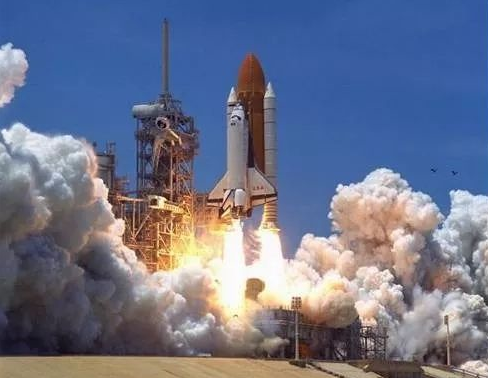
Space Shuttle Columbia’s launch on April 13, 1981
A space shuttle takes off like a rocket, orbits like a satellite and glides like a plane. Just like the 12-nautical-mile demarcation line is the boundary between territorial sea and high seas, the 100-kilometer Karmen line is regarded as the dividing line between territorial space and outer space. A space shuttle shuttles back and forth between the outer space and the ground. A space shuttle has an external tank that supplies the liquid oxygen and hydrogen fuel to the main engines. It is also the backbone of the launch vehicle, providing attachment points for the two solid rocket boosters and the orbiter. The external tank was the only part of the Shuttle system that was not reused. It drops off 8 and a half minutes after launch. Two solid rocket boosters (SRBs) provide 83% of the total thrust at liftoff. The SRBs are jettisoned two minutes after launch, and then deploy parachutes and land in the ocean to be recovered. The most essential and core part is the orbiter, comprising most of the fuselage. The orbiter resembled a conventional aircraft, with double-delta wings adapted to hypersonic, supersonic, subsonic and horizontal landings. A space shuttle can carry seven crew members and 30 tons of payload. Payloads were generally loaded horizontally into the bay while the orbiter was standing upright on the launch pad and unloaded vertically in the near-weightless orbital environment by the orbiter's robotic remote manipulator arm. A space shuttle is made up of 2.5 million parts which can be reused hundreds of times.
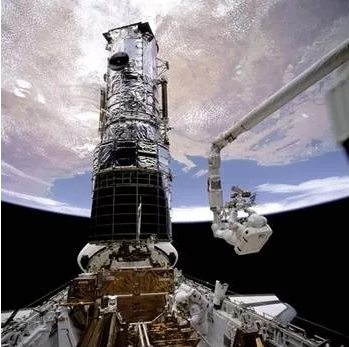
Endeavour astronaut Musgrave repairing the Hubble Space Telescope on a robotic arm in 1993
After Columbia in 1981, more space shuttles have been launched, the Challenger, the Discovery, Atlantis, and Endeavour. Space shuttles have carried satellites into the space and repairs satellites, and transported goods to space stations. The Hubble Telescope had gone up with the space shuttle Discovery, and been repaired by subsequent missions so that humans have been able to observe the universe. During space walks, the cosmos suits were the smallest and intimate “personal spacecrafts”. On September 12, the Endeavour’s astronauts MarkLee andJan Davisbecame the first couple in space. On October 29, the first American astronaut John Glenn returned to space aboard the Discovery at the senior age of 77. Space shuttles are memories of a great age.

The first American astronaut John Glenn going back into spacein 1998aboard the space shuttle Discovery
The loss of the Soviet space shuttle Buran is deeply regrettable. The explosion of the Challenge on October 5, 1984 and the Columbia disintegration while it was landing on February 1, 2003 were tragic memories. The humans, however, understand that the journey of the universe takes tolls. After 2010, the remaining three space shuttles have been decommissioned and taken over by a more secure and reliable new generation of spacecraft Orion, and the United States has shifted from the versatility model to the upgraded Apollo framework for space exploration. Orion will continue the journey to the moon and even Mars.
Space messenger: Alien Detectors
In fact, human spaceflights have not been limited to the Earth's orbit. The United States and the Soviet Union, since the beginning of the space race, had tried to rush out of the Earth's gravity and visit our “neighbors” in the solar system.The first Mercury probe was Mariner 10launched on November 3,1973 which had flown over Mercury three times and sent back 2,800 The pictures. It is still running around the sun. The Messenger launched on August 3, 2004 has given us a fuller understanding of Mercury, the closest planet to the Sun.
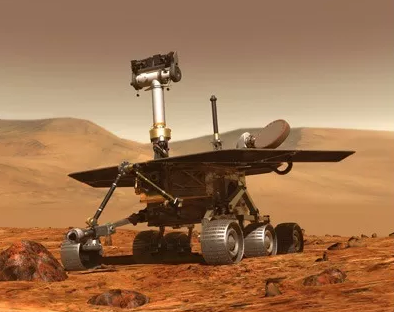
Mars Rover “Spirit”
Mars is the planet of the solar system about which humans have the most knowledge except Earth. On November 28, 1964, NASAlaunched its Mars probe Mariner 4, confirming that Mars is a lifeless world without so-called canals. Since then, science fiction writers have stopped writing about Martians. Of all the remaining Mars probes of the United States and the Soviet Union, the Viking 1 and Viking 2 are most outstanding. Both landed on Mars on the cushion of an airbag, and have sent back thousands of high-definition photos. The most incredible are the Spirit landing on Mars on January 4, 2004 and the Opportunity landing in the opposite hemisphere of Mars 3 months later. With a design life of 3 months, both Mars probes have remained robust after 5 years on Mars, thanks to the superb control on the Earth. In contrast,the Phoenix, which landed at the north pole of Mars on May 25, 2008 and found water, was unable to withstand the cold weather and lost contact with the Earth in the same year. People are expecting the Phoenix to wake up.
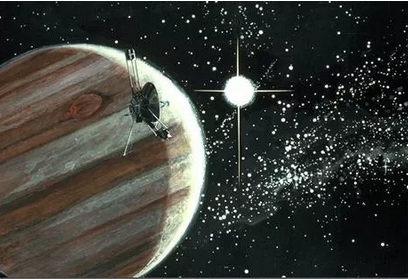
Pioneer 10 flying to Jupiter in 1972
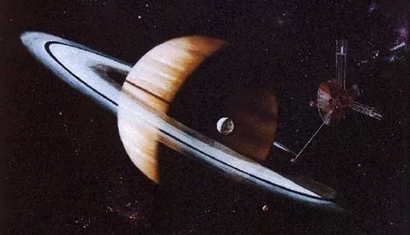
Pioneer 1 flying to Saturn
The large Jovian planets on the outer rings of the solar system do not have rock shells, unlike the compact terrestrial planets, but are composed of gaseous and liquid hydrogen, helium, ammonia and methane. Pioneer 10 and Pioneer 11 were the first probes to explore the Jovian planets. Pioneer 10 went up on March 3, 1972 and sent back the first photos of Jupiter in December. In June 1983, it crossed Neptune's orbit and flew out of the solar system, then gradually fading away from the radar screen. In January 2003, it lost final contact with the Earth12 billion kilometers away in space. Pioneer 11, departing the Earth on April 6, 1973, had not only visited Jupiter, but also used Jupiter's gravitational force to change its orbit, reaching Saturn in September 1979 and leaving the solar system without a trace thereafter.

Roadmap of Pioneer 10, Pioneer 11, Voyager 1 and Voyager 2
Voyager 1 and Voyager 2 launched on September 5 and August 20, 1977 are twin probes. They seized the once-in-176-year opportunity of outer planets going in a straight line, and used Jupiter as a springboard to Saturn, using the gravity-assist technique. Voyager 1 took a shortcut to Jupiter and Saturn in early 1979 and late 1980, and sent back full views of the two giants in the solar system and their satellites. Voyager 2 had a close-up observation of Uranus and Neptune in January 1986 and August 1989. Up to now, Voyager 1 is the human messenger that has travelled the farthest from the earth, 16.5 billion kilometers away and it took 15 hours for its signals to arrive the Earth. Another probe, the Galileo probe, is a great pity, as after observing Jupiter for 14 years and remaining on the orbit around Jupiter for 35 weeks, it received the Earth's "suicide" order. It ran into Jupiter at the speed of 50 kilometers per second, in order to avoid the possibility of carrying the Earth bacteria to Europa, the second moon out from Jupiter.
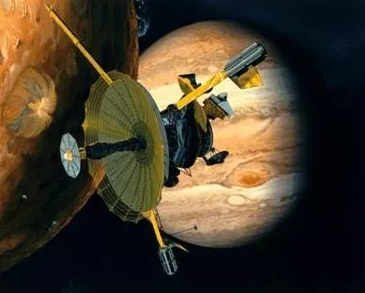
Galileo spacecraft orbiting Jupiter

Cassini-Huygens detecting Saturn's halo
The next big step in space took place on January 14, 2005 when the Huygens probe detached from the Cassini orbiter and then opened a parachute over Titan, Saturn's largest satellite, to make the most distant human landing in the outer space. Humans have visited eight other planets of the sun so far, and the only exception is Pluto, which was reclassified as a dwarf planet in 2006 for it cannot clear the neighborhood around its orbit like a normal planet. On January 19, 2006, the New Horizons spacecraft made its closest approach to Pluto on July 14, 2015.
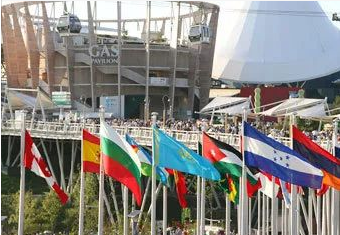
World Expo 2005 Aichi
The United States pavilion at Expo 2005 Aichi followed the spirit ofFranklin. It tells the story of Benjamin Franklin using a kite to capture lightning on a storming day, stressing the pioneering and creative spirit of the nation. In the story, Benjamin Franklin is a versatile person of conflicting features, but one of the best representatives of the American spirit: perseverance, dedication to science and strong commitment to truth. The Expo also showed a large number of photos sent from Mars rovers more than 100 million kilometers away.
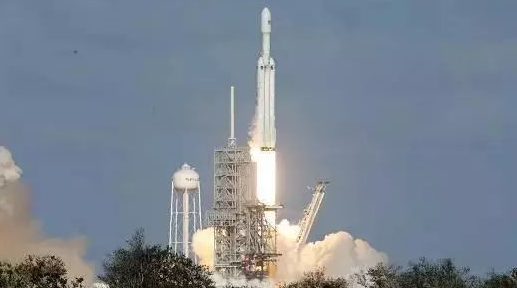
Super launch vehicle– Falcon Heavy
The key headlines on the frontpage of major media these days are all about the American private aerospace company SpaceXlaunching a super launch vehicle that is far beyond all rockets in the world today: Falcon Heavy. Elon Musk, the company’s founder, made it clear in an interview that Benjamin Franklin is his hero and idol. It also explains why he wants to explore the outer space and has challenged many traditions of our real life to turn science into a spiritual driving power for all.
China's space dream: To land on the moon and “chase” the sun
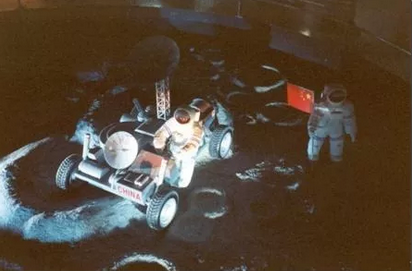
Model of China’s moonrover at the China Pavilion at World Expo Hannover 2000
The rise of China's aerospace industry has brought a new thrust to the cause of space exploration. At World Expo Sevilla1992and World Expo Taejon 1993, China exhibited its Xichang rocket launcher and models of the Changzheng launch vehicles. With the success of AsiaSat 1 and the AusSat, China rapidly emerged as a key player in the world's rocket launch market. AtWorld Expo Lisbon 1998, China did a simulation satellite launch, and the China Pavilion at World Expo Hannover 2000 exhibited China’s future space shuttle, space station and moon rover. The world saw a great nation's lofty goals and ambitions.
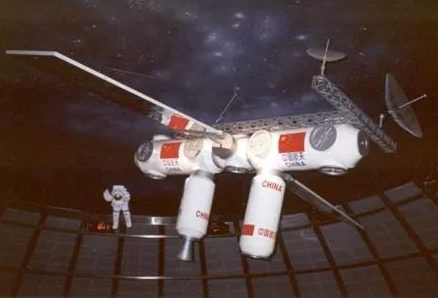
Model of China’s space station at China Pavilion of Expo Hannover 2000
After the launch ofShenzhou 5 at 9 am, October 15, 2003, China has become the third country after the Soviet Union and the United States capable of manned spaceflight. In October 2005, Shenzhou 6 completed its multiple-day multi-man space flight; in September 2008, Shenzhou 7performed China’s first spacewalk. Yang Liwei, Fei Junlong, Zhai Zhigang and other several other astronauts have made their entry in the world history of space conquest. In October 2007, China launched Chang’e 1, China’s unmanned lunar-orbiting spacecraft, as part of its Lunar Exploration Program. In 2010, China began its Tiangong program to build its own the space station. In 2012, China began its Kuafu program, a space project to establish a space weather forecasting system named after a giant in Chinese mythology who chased the sun. The Chinese people are gradually realizing the ancient dream of “scaling the sky”.
“Bottles” in the cosmic “ocean”
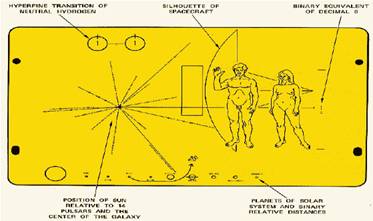
The gold-plated aluminum plaque on Pioneer spacecrafts
Both World Expo1939 in New York and World Expo 1970in Osaka World Expo buried Time Boxes containing over a thousand objects to be unearthed by human beings 5,000 years later, allowing distant descendants to interpret the history and civilization of their ancestors. Humans have also sent similar Time Capsules into the space through space probes.
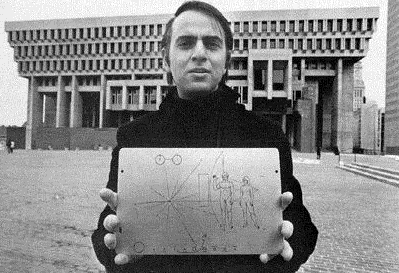
American astronomer CarlSagan showing the gold-plated aluminum plaque on Pioneer spacecrafts
Pioneer 10 and 11 both carry a gold-anodized aluminum plaque in the event that either spacecraft is ever found by intelligent lifeforms from other planetary systems. 23 cm long and 15 cm wide, the plaques feature the nude figures of a human male and female along with several symbols that are designed to provide information about the origin of the spacecraft.They were designed by the American astronomer and popular science writer Carl Sagan and his wife Linda Sagan. Spacecrafts Voyager 1 and Voyager 2 carried golden records that contained sounds and images selected to portray the diversity of life and culture on Earth, and are intended for any intelligent extraterrestrial life form, or for future humans, who may find them. Those records are considered as a sort of a time capsule. The Voyager Golden Record contains 116 images plus a calibration image and a variety of natural sounds, such as those made by surf, wind, and thunder, and animal sounds, including the songs of birds and whales. The record also features musical selections from different cultures including China, spoken greetings in fifty-nine languages, and printed messages from President Jimmy Carter and U.N. Secretary-General Kurt Waldheim. The record is constructed of gold-plated copper and is 12 inches (30 cm) in diameter. The record's cover is aluminum and electroplated upon it is an ultra-pure sample of the isotope uranium-238. Today, the space probes have left the solar system, and become bottles in the cosmic ocean. They will outlive the solar system. If intelligent living beings from other galaxies obtain them billions of years later, they will be deeply touched by the kindness and affection of human beings on Earth.
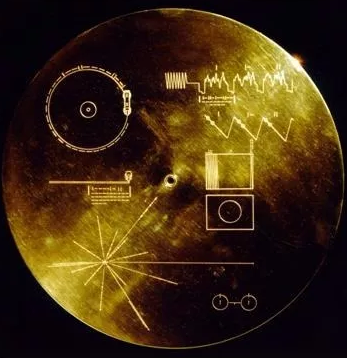
Electroplated cover of the Voyager Golden Records on board the Voyager spacecraft
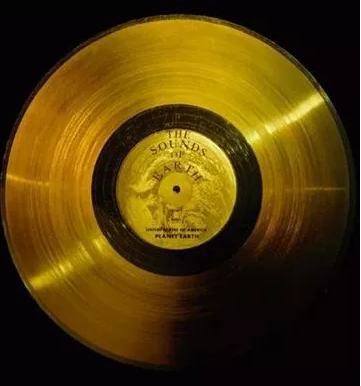
Case of the Voyager Golden Records on board the Voyager spacecraft
A more realistic Time Capsule in the space project is UNESCO’s KEOsatellite, a “project of the 21th century”. The three letters K, E and O are the most frequently occurring pronunciations in most languages in the world. KEO satellites have been launched on Ariane rockets and are expected to land on Earth 50,000 years from now. KEO organizers call for everyone in the world to contribute to the time capsule. The organizers also encourage everybody to gather messages from children, senior citizens and the illiterate so that every culture and demographic on Earth is represented. The satellite has enough capacity to carry a four-page message from each of the more than six billion inhabitants on the planet. KEO will also carry a diamond that encases a drop of human blood chosen at random and samples of air, sea water and earth. The DNA of the human genome will be engraved on one of the faces. It aims to become "the contemporary Library of Alexandria", an encyclopaedic compendium of current human knowledge. The messages and library will be encoded in glass-made radiation-resistant DVDs. Symbolic instructions in several formats will show the future finders how to build a DVD reader. The KEO time capsules are not buried in any national territory, or subject to erosion in the earth environment. They are deposited with the God. When we write the message for our descendants of 500 century later, we will surely feel holy and warm with love.

Contents of the Time Warehouse on board the KEO satellite
Perhaps no science has accompanied the progress of human civilization, profoundly influenced the development of philosophy, religion and culture, and united the world's populations like astronomy. People who have never looked up at the starry sky will not have deep thoughts, and the passion to explore the universe is often accompanied by a broad mind and a pure heart. What is the ultimate meaning and eternal value of all our efforts? Where is the rationality of human existence and the possibility of its perpetuation? When we develop a clear concept of the universe and understand our position in the vast environment, science becomes a part of faith. It will be our never-ending pursuit and glory to push back the frontiers of knowledge about the universe.
